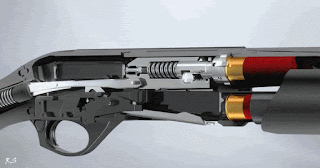Nope. The piston strokes up-and-down. The engine fires once every four strokes, hence the clarity of the term "four stroke"
2-Stroke motors are magic. The rely on fluid dynamics, reed valves, piston position and pixie dust to work.
The piston uncovers the outlet port first and the hot, combusted gasses make a mad dash for the exit.
Visualize a "Slinky". The momentum of the slinky is outward bound. Then the piston uncovers the inlet port and the slightly pressurized, uncombusted air-fuel mix can enter...but typically is further pressurized by the combusted gasses leaking backwards.
Timing is everything. The back edge of the slinky, which has been pressurized by the erstwhile exhaust gas, makes a final jump into the combustion chamber like Indiana Jones sliding beneath the wall of stone about to seal his doom.
So, what does a 1-Stroke, Internal Combustion engine look like?



Clever.
ReplyDeleteNice explanation.
ReplyDeleteI was taught 4-cycle operation and helped to memorize it by being given the description of a 4 Stroke engine operation as "Suck, Squeeze, Bang, Blow".
Rather a memorable and accurate description, and it helped on the Private Pilot Oral Exam.
Pugsley: "Technically the truth."
ReplyDelete